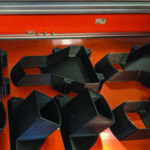There have been a bunch of very large investments this week. We’ve previously covered GM doubling down on additive manufacturing in their North American factories. This time around we have two separate stories of big investments. The first is from chemical giant Henkel and the second is from Sauber Group, the company behind the Alpha Romeo F1 team. In the case of both companies, they’ve stated that 3D Systems will be be their partner. Henkel will be equipping their labs with HP and Carbon’s additive manufacturing devices.
Henkel is investing 18 million Euros into its laboratories in Ireland, whereas Sauber has added 5 new ProX 800 3D printers to its stock. Sauber has already used 3D Systems’ technology and are now updating their stock. Henkel, a leading manufacturer of adhesives, will be expanding their HQ to 2,000 sq metres, with five additional labs. The latter program will find support with the Irish government through the IDA.
Investment Craze
While Henkel hope to use the printers to develop advance materials, Sauber wish to support Alpha Romeo with wind tunnel testing. The former company has more diverse plans than Sauber, as they also provide training and support. They are a hub of training for medtech, automotive and manufacturing industries expert training.
Both companies have very complex needs and this is reflected in their investment patterns. One commonality they share is the perspective that 3D printing is disruptive. “Additive manufacturing will be a significant disrupter to future manufacturing methodologies,” explained Henkel technology centre director Dr Matthew Holloway.
Why do we 3D print the tools instead of using conventional tooling techniques? The answer is easy – we get the design complexity for free! This is absolutely essential for parts like complex duct systems.” Said Christoph Hansen, head of AM, at Sauber.
The rising investment in 3D printing is providing both quality and cost cutting for a host of world-class companies. The opportunities that 3D printing can provide are causing a shift away from traditional manufacturing. This is particularly the case for prototyping and carbon-fiber production. As the technology gets more sophisticated, we can expect more companies to jump on board.
Featured image courtesy of engineering live.



